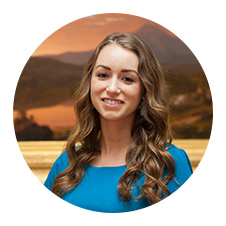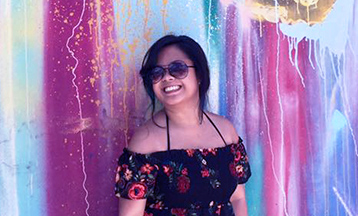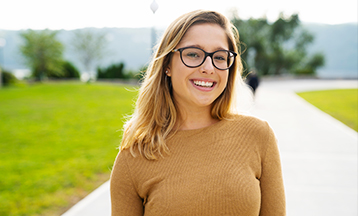-
About
Marist Commencement
Celebrating the Class of 2025
• The graduate ceremony will be held on Friday, May 23.
• The undergraduate ceremony will be held on Saturday, May 24.About
-
Academics
Marist Commencement
Celebrating the Class of 2025
• The graduate ceremony will be held on Friday, May 23.
• The undergraduate ceremony will be held on Saturday, May 24.Academics
-
Admission & Financial Aid
Marist Commencement
Celebrating the Class of 2025
• The graduate ceremony will be held on Friday, May 23.
• The undergraduate ceremony will be held on Saturday, May 24.Admission & Financial Aid
-
Student Life
Marist Commencement
Celebrating the Class of 2025
• The graduate ceremony will be held on Friday, May 23.
• The undergraduate ceremony will be held on Saturday, May 24.Student Life
- Athletics
Students talking to each other in front of posters

Julianna White
Washington, DCAcademic School
Communication & the ArtsCampus
New YorkWhen I went on my first campus tour, I was drawn in by the Hudson Valley views and the almost overly cheerful faces. The study abroad program convinced me to say “yes” to Marist. I would end up doing two short-term study abroad programs; one in Spain, one in France, and a semester in Florence. These were some of the best experiences of my life, but it was the people within the Art History Department—the professors, advisors, and friends—who shaped my path in the art world and got me to where I am today.
Now, as an Editor at the Smithsonian American Art Museum, I get to craft content and language that reaches people all over the world. From exhibition catalogs to gallery labels and digital text, I work with curators, educators, and designers to find the best ways to connect everyone to art.
I fell in love with Art History my junior year of high school. At Marist, along with general survey courses, I sought out specific studies such as Women Artists and Seventeenth-Century Dutch Painting. I found, however, the courses I was most drawn to were created by Dr. Anne Bertrand-Dewsnap, Lecturer for Core Art History, and I began to arrange my schedule around what she taught. With her, I studied Francisco Goya and Diego Velázquez, and then spent two weeks traveling around Spain with a small group of students seeing their artworks in person. I studied the French Impressionists and then spent another two weeks at all the great museums in Paris, even coming face-to-face with the gargoyles on the top of Notre Dame—a now an even more cherished memory.
Back then, I was one of just a handful of Art History majors, but my professors and advisors— like Dr. Bertrand-Dewsnap and Professor of Art and Gallery Director Ed Smith especially—made sure I received the knowledge and tools I needed to turn a spark of interest into a real future. I would not have been able to grasp the study abroad programs if not for their encouragement, and I landed my first internship at the Olana State Historic Site with Dr. Bertrand-Dewsnap's connections and guidance. When I expressed my passion for Art History at one of my first advisor meetings with Professor Smith, he responded, “Well then, we’re going to make sure you spend a semester in Florence.” They truly made me feel like nothing was out of my reach if I put in the work.
After being told to “aim high” by Professor Smith during my senior year at Marist, I was accepted into New York University’s Institute of Fine Arts graduate program. Dr. Bertrand-Dewsnap went out of her way to prepare me, lending me books and always making herself available to dish out honest advice. The connections I made at my first internship while at Marist inspired my master’s thesis on Frederic Church, as a collector of old master paintings. The year after graduate school, I explored a few different avenues in the art world, including an auction house, a historic home, and a research-based curatorial internship within the Metropolitan Museum of Art’s American Wing. I kept in touch with my Marist mentors along the way, and they always enthusiastically said yes to any recommendation requests.
I finally landed my first full-time position as an editorial assistant at the Yale University Art Gallery, an exceptional encyclopedic museum of nearly 300,000 artworks. Having known me so well, Dr. Bertrand-Dewsnap and others encouraged me to accept this position over an art gallery assistant job in New York City. At Yale’s art museum, I learned the art of editing and book production, while gaining better insight into the teamwork it takes to run a museum. Two years later, I landed a dream job at the Smithsonian in Washington, DC, as a junior editor. Now, after more than five years as an editor at the American Art Museum, I’ve worked on books, exhibitions, and more, over a wide range of topics—ever-learning something new, including how nineteenth-century painters influenced the exploration of our Nation, how artists responded to the American War in Vietnam, and how contemporary craft artists are capturing our present moment.
My trusted Marist advisors turned into mentors, who then turned into friends. I was always treated as their equal and their colleague before I earned that title. I felt their pride and support every step of the way, and I will be forever grateful. I did not realize the full value of the program at the time, but now I know how lucky I was to be a part of it. It is such a joy to see the Art History department continue to grow.



